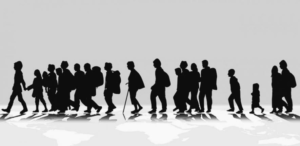❈ ❈ ❈
With Pandemic a ‘Tipping Point,’ UN Warns 1 Billion More People Headed for Extreme Poverty by 2030
Kenny Stancil (Common Dreams)
December 03, 2020: A harrowing study released by the United Nations early Thursday reveals that the global coronavirus pandemic is setting the stage for a massive surge in the number of people pushed into poverty worldwide over the next decade—a phenomenon that only immediate interventions in the form of ambitious investments in public health, social safety net programs, and a green transition can help avoid.
According to the findings of the new study by the United Nations Development Programme (UNDP), the “severe long-term effects” of the global pandemic could push an additional 207 million people into extreme poverty over the next decade. On top of the current pandemic trajectory, that would bring the total number of individuals living in extreme poverty to over 1 billion by 2030—this at a time of rampant and nearly unparalleled inequality as the fortunes of the world’s richest individuals and families continue to soar.
While the UNDP makes clear the looming intensification of poverty is not a forgone conclusion, only with urgent action can such a scenario be avoided.
The analysis considers various recovery pathways and predicts how each one would affect the U.N.’s Sustainable Development Goals (SDGs).
Under the ‘Baseline’ scenario, based on current mortality rates and growth projections, 44 million more people will likely be pushed into extreme poverty by 2030 than would have been expected before the Covid-19 pandemic altered the world’s development trajectory.
In a ‘High Damage’ scenario in which the recovery is protracted—meaning that 80 percent of economic productivity losses remain after 10 years—207 million additional people are projected to be living in poverty, bringing the total to 1 billion by the end of the decade.
Worsening poverty is not inevitable, however. The UNDP also finds that a “focused set” of interventions to attain the SDGs, which the authors call the ‘SDG Push’ scenario, could lift 146 million people out of extreme poverty compared to the current pandemic-driven trends and reduce the gender poverty gap, too.
By making SDG investments over the next decade in social protection as well as digital and green economic development, “we can accelerate out of this crisis,” the report says.
According to the UNDP, the benefits of a strong SDG push “are echoed across additional human development indicators, including nutrition and education.”
❈ ❈ ❈
Urging Tens of Billions in Emergency Aid, Top UN Officials Warn 2021 Set to Be ‘Catastrophic’ for World’s Poorest
Julia Conley (Common Dreams)
Meanwhile, World Food Programme (WFP) chief David Beasley warned that famine is “knocking on the door” for a number of developing countries and conflict zones including Yemen, Burkina Faso, northeastern Nigeria, and South Sudan. Beasley was joined by World Health Organization (WHO) head Tedros Adhanom Ghebreyesus in calling for $35 billion in humanitarian aid for countries where millions were already facing displacement, hunger, and public health crises before the coronavirus pandemic began.
The number of people in need of humanitarian aid has increased by 40% this year, as the rapid spread of Covid-19 has forced many to go with reduced incomes, or not at all, amid lockdowns.
The dire situation for poor countries is being compounded by what Tedros called a “vaccine stampede” which appears set to continue into 2021.
In recent weeks, pharmaceutical companies Pfizer and Moderna have announced promising results of their coronavirus vaccine trials, with the earliest-available doses expected to get to some people in the U.S. by the end of December.
Within days of Pfizer’s announcement that its trial had yielded promising results, 80% of the company’s vaccine supply had already been sold to several of the richest countries in the world, comprising just 14% of the global population. Seventy-eight percent of Moderna’s vaccine was also claimed by wealthy countries shortly after the company’s announcement.
The WHO chief called for an immediate investment of $4.3 billion for the global Covax facility, an initiative to ensure equitable access to vaccines in order to protect public health around the world. Next year, the facility will need an injection of $7.8 billion from international donors, plus funding to help set up distribution systems.
“We simply cannot accept a world in which the poor and marginalized are trampled by the rich and powerful in the stampede for vaccines,” Tedros told the U.N. General Assembly on Friday.
“This is a global crisis and the solutions must be shared equitably as global public goods,” Tedros said.
❈ ❈ ❈
Billionaire Wealth Swells by $1 Trillion as Food Lines Stretch ‘As Far As the Eye Can See’
Kenny Stancil (Common Dreams)
Illustrating the intensifying inequality that has defined life in the United States for the past four decades—spotlighted throughout the coronavirus crisis—the total amount of wealth gained by the nation’s 650 billionaires since March surged past $1 trillion amid Tuesday’s record-breaking day on Wall Street, which coincided with reports that 26 million Americans are experiencing hunger.
“The increases in billionaire wealth continue to defy gravity in the real economy where millions have lost their jobs, health, and livelihoods,” said Chuck Collins, a scholar of inequality at the Institute for Policy Studies (IPS), a progressive think tank,
The $1 trillion growth in U.S. billionaire net worth since March represents an increase of more than one-third. Collins noted that 29 billionaires have seen their wealth double since the pandemic began, and the combined wealth of this super-rich class is now “twice the amount of wealth held by the bottom 50% of households combined, roughly 160 million people.”
Meanwhile, the Washington Post on Wednesday published a harrowing photo essay documenting the worsening hunger crisis in the U.S., where “26 million now say they don’t have enough to eat, as the pandemic worsens and holidays near.”
The Post‘s reporting comes only days after CBS News shared a video in which thousands of people are shown waiting—in lines of vehicles that stretch “as far as the eye can see”—to collect food.
Miles-long food lines are one of the most visible signs of the country’s descent into economic devastation, but a more severe plunge may be on the horizon. The impending expiration of federal unemployment benefits threatens further financial hardship for an estimated 12 million Americans the day after Christmas, and the end of the national eviction moratorium and student loan forbearance is also looming.
In response to last month’s news that the combined wealth held by the world’s 2,189 billionaires had surpassed $10 trillion, British Labour Party Member of Parliament Richard Burgon argued that the yawning chasm between the super-rich haves and the struggling have-nots is “not a coincidence.”
This growing divergence, Burgon noted, is “how their rotten system works.”
An economy of this sort is “fatally flawed,” said labor historian and organizer Jane McAlevey.
❈ ❈ ❈
Income of Top 0.1% Soared 345% While That of Bottom 90% Stagnated Over Past 40 Years
Brett Wilkins (Common Dreams)
U.S. wage data released this week reveal the continuation of a trend that began at the end of the 1970s, and which has given the United States the dubious distinction of having the worst income inequality among most-developed countries.
The Economic Policy Institute reports that between 1979 and 2019, the top 1% of people in the U.S.—whose mean income was nearly $738,000 in 2018— have enjoyed 160% income growth, while wages for the bottom 90% have stagnated, rising just 26% over the same 40-year period.
The figures showed massive inequality even among the top 1%, as the highest 0.1%—those making an average of $2.82 million—skyrocketed 345% since 1979.
While U.S. income inequality is the worst among most-developed nations, its wealth inequality is even more egregious. According to a 2017 report from the Institute for Policy Studies, the three wealthiest Americans at the time, Jeff Bezos—who has since become the world’s first multicentibillionaire—Bill Gates, and Warren Buffett, collectively held more wealth than the bottom 50% of the population, or some 160 million people.
Experts say it is no accident that the period in which the yawning, ever-growing chasm between rich and poor began coincides with the rise of corporatist and neoliberal economic policies—colloquially dubbed “trickle-down economics”—implemented by conservative leaders including British Prime Minister Margaret Thatcher and President Ronald Reagan in the U.S.
(All the articles above are extracts from articles published in Common Dreams, a US non-profit news portal.)
❈ ❈ ❈
The Top 1% of Households Own 43% of Global Wealth, 10% Owns 81%, While the Bottom 50% have Just 1%.
Michael Roberts
At the end of 2019, the top 1% of households globally own 43.4% of all personal wealth. The 1% are all millionaires in net wealth (after debt) and there are 52m of them. Within this 1%, there are 175,000 ultra-wealthy people with over $50m in net wealth – that’s a miniscule number of people (less than 0.1%) owning 25% of the world’s wealth! In contrast, 54% of adults with wealth below USD 10,000 (ie pretty much nothing) together mustered only 1.4% of global wealth.
This information comes from the 2020 Credit Suisse Global Wealth report which has just been released. The report remains the most comprehensive and explanatory analysis of global wealth (not income) and of the inequality of personal wealth. Every year the CS global wealth report analyses the household wealth of 5.2 billion people across the globe. Household wealth is made up of the financial assets (stocks, bonds, cash, pension funds) and property (houses etc) owned. And the report measures this, net of debt.
As shown by the wealth pyramid graphic below, inequality of household wealth remains stark globally, both geographically between the ‘rich north’ and ‘poor south’; and between households within countries.
Figure: The Global Wealth Pyramid, end-2019
At the end of 2019, North America and Europe accounted for 55% of total global wealth, with only 17% of the world adult population. In contrast, the population share was three times larger than the wealth share in Latin America, four times the wealth share in India, and nearly ten times the wealth share in Africa.
Wealth differences within countries are even more pronounced. The top 1% of wealth holders in a country typically own 25%–40% of all wealth, and the top 10% usually account for 55%–75%.
In short, what the report shows is billions of people have no wealth at all after debts and that the distribution of global personal wealth can be described as a few Gulliver giants looking down on the mass of Lilliputians.
(This article is an extract. Michael Roberts is London-based socialist economist, and author of several books, and writes regular commentary and analysis on contemporary global economy on his blog, ‘The Next Recession’.)
❈ ❈ ❈
Landmark Study Shows $427 Billion Lost Each Year to Tax Dodging by Corporations and the Rich
Julia Conley
A first-of-its-kind international report released Friday shows how wealthy countries are the primary drivers of tax revenue loss each year—contributing to $427 billion in losses to public funding annually and affecting the ability of countries all over the world, including developing nations, to provide services to the public.
The Tax Justice Network’s inaugural State of Tax Justice report is the first study to thoroughly measure how much money each country loses each year to corporate tax abuse and private tax evasion, using data that was self-reported by corporations to tax authorities.
The report notes that in light of the global coronavirus pandemic, the loss of revenue to tax abuse and evasion has major implications for public health efforts. One nurse’s annual salary is lost every second to tax havens—the equivalent of 34 million nurses’ salaries each year.
“A global tax system that loses over $427 billion a year is not a broken system, it’s a system programmed to fail,” said Alex Cobham, chief executive of the Tax Justice Network.
“Under pressure from corporate giants and tax haven powers like the Netherlands and the U.K.’s network, our governments have programmed the global tax system to prioritize the desires of the wealthiest corporations and individuals over the needs of everybody else,” he continued. “The pandemic has exposed the grave cost of turning tax policy into a tool for indulging tax abusers instead of for protecting people’s wellbeing.”
Lower-income countries are particularly affected by tax evasion during public health crises like the current pandemic, with losses equivalent to 52% of their public health budgets. While rich countries lose hundreds of billions more dollars each year to tax evasion and abuse, their losses only make up about 8% of their public health budgets.
Latin America and Africa’s tax losses are equivalent to about 20.4% and 52.5% of their public health budgets, respectively.
Contrary to data compiled in the European Union’s “highly politicized blacklist” of tax havens, the Tax Justice Network said high income countries are behind a vast majority of global tax abuse. The British territory Cayman Islands is responsible for other countries losing $70 billion in public funding each year, while the U.K.’s tax laws take away more than $42 billion. The U.S. is in fifth place globally, robbing other countries of $23.6 billion each year.
While countries including Palau and Trinidad and Tobago are on the EU’s blacklist and are not cooperative with international tax regulations, the Tax Justice Network reported, they “did not create any observable tax losses for other countries.”
Meanwhile, high-income countries are behind 98% of public funding losses around the world, contributing to a loss of $419 in annual tax revenues.
Countries / Territories Responsible for Highest Annual Tax Losses to Other Countries
Corporate abuse by multinational corporations is directly responsible for the loss of $245 billion each year, with companies shifting $1.38 trillion in profits out of the countries where those profits were earned into tax havens, the report said. Private tax evaders also stored a total of $10 trillion in offshore accounts, leading to a loss of $182 billion in public funding.
(Extract from an article published in Common Dreams, a US non-profit news portal.)




